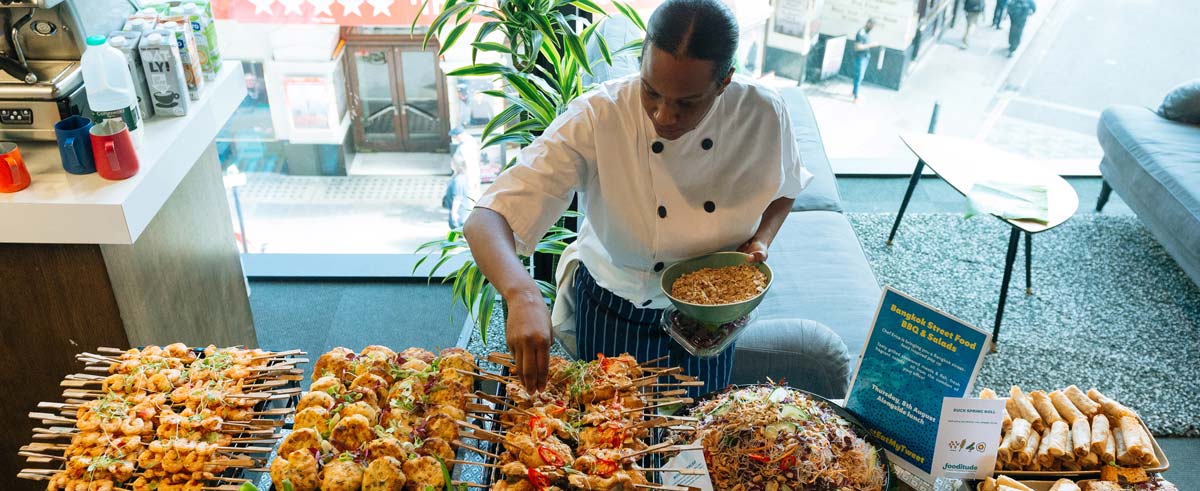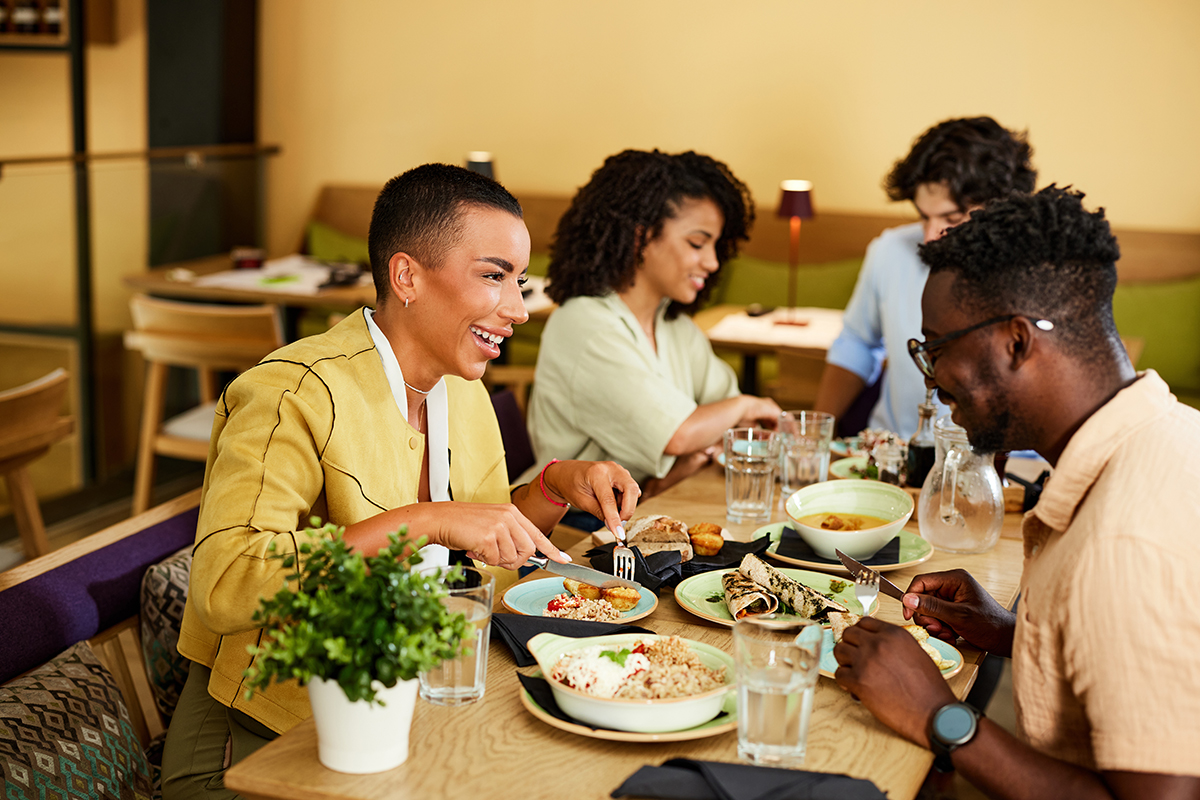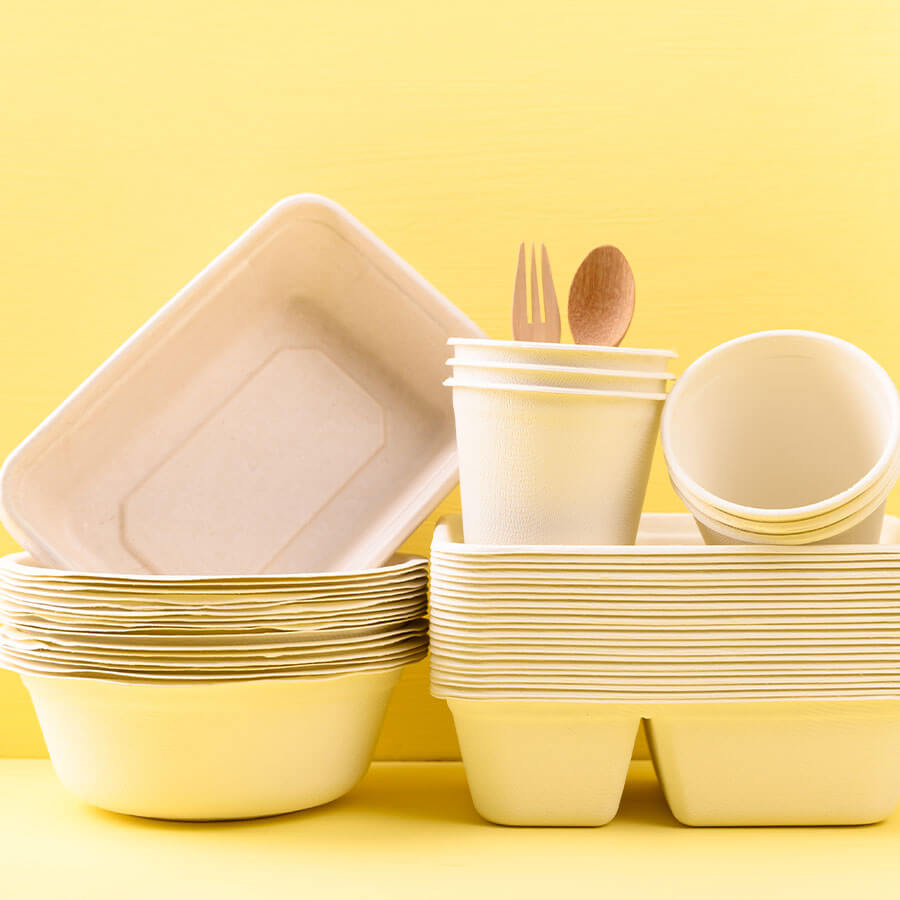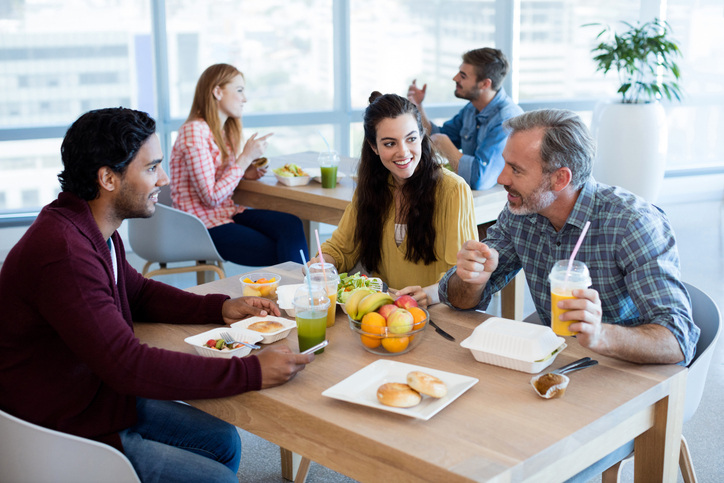Office Catering: The Essential Guide For Office Managers

Office catering is more than just offering the perk of free food; it’s becoming a key part of a fun and lively office environment, especially in many of the tech companies you’ll find around London.
It’s about keeping employees happy and productive by offering them a variety of tasty food right where they work. Sharing good food together helps build a strong team spirit and can even spark new ideas and creativity.
This guide serves as a comprehensive tool for those of you in charge of enhancing workplace environments. We will delve into various catering options, ranging from traditional setups to newer, more modern solutions.
Whether you’re managing a small team or a large corporate space, this guide aims to provide you with the insights and knowledge to select the best catering approach that aligns with your office’s specific needs and dynamics, with a nod to making things more sustainable.
Our goal is to give you all the information you need to make the right choices about office catering that not only feed your team but also help make your workplace a more welcoming and lively place to be.
Let’s get going…
What is Office Catering?
Office catering refers to the service of providing food and beverages to employees within a workplace. It encompasses a range of services, including the regular provision of meals such as breakfast, lunch, or dinner, as well as catering for special office events, meetings, and conferences.

There’s no ‘one way’ to provide office catering; multiple approaches to feeding people at work exist. There are traditional setups with on-site kitchens as well as emerging, modern ways to feed teams. These range from delivered-in catering to food aggregators that provide various options from different providers. The main goal of office catering is to offer meals that bring people joy while being convenient and nutritious.
Here’s what you can expect from office catering
Daily Meals and Food Programmes
The importance of daily meals and food programmes is growing. Companies are now realising office catering has the potential to do more than provide sustenance; it’s about empowering employees with the choice of how they can eat at work.
Whether it’s somebody wanting to tuck into a vibrant salad, a hearty hot dish, or treat themselves to a snack mid-afternoon, office catering is required to match the diversity of the eating habits of employees.
While offering lunch is the most popular option, you have the choice on what you offer your employees based on how your organisation operates and what type of perks you want to include.
Perhaps you want to offer your team an energising breakfast to kick off their mornings, followed by a delicious, varied buffet lunch that fuels their afternoon’s tasks. Maybe you want to extend your office catering to offer dinners for those with later working hours?
Your office management team can shape your catering services to match the unique way that your company works, whatever the schedules of your employees.
By offering a wide range of choices - from healthy salads and wraps to warm, comforting dishes - these programmes ensure that there are appetising and delicious options for everyone, when they want it.
Meeting and Conference Catering
When there are important meetings or workshops, the right food can make all the difference. Catering services can come up with specialised menus that suit the tone and duration of these events. Whether it’s light snacks to keep everyone alert or a more substantial meal for longer sessions, a good caterer should flex to the event’s specific needs.
Pop-Up and Event Catering
Office events and parties get a whole lot better with catering services that bring the excitement of fun and interactive food stations for example. From gourmet treats to fun and trendy street food, they can provide something markedly different to the daily food offering with truly memorable culinary experiences.
Specialised Catering
For events, big dates or even celebrations, menus can be themed to fit the cultural or festive mood, adding an extra touch of thoughtfulness. Themed menus help to create a sense of interconnectivity and occasion in the workplace, with specially designed dishes made to celebrate significant milestones in the international calendar.
To sum it up, office catering is about so much more than just feeding people. It’s a way to enhance the overall work experience, to show employees they’re valued, and to bring a sense of togetherness and well-being into the office. It’s about turning meal times into opportunities for connection, creativity, and satisfaction.
What are the Different Types of Office Catering Models?

Traditional Office Catering
Traditional office catering refers to the classic approach of providing meals within the workplace. It typically involves setting up an on-site kitchen where meals are prepared and served by a dedicated culinary team.
This type of catering is often found in larger companies that have the space and resources to accommodate a full kitchen and dining area.
Traditional office catering is characterised by its ability to offer a wide range of hot and cold menu options, cooked and served right on the premises.
Food Aggregators
Food aggregators in office catering are a modern solution for varied meal options, combining offerings from multiple restaurants into one easy-to-access platform. They cater to offices that might not have their own catering facilities or those seeking diversity in their meal choices.
Offices usually use this type of food service for its convenience and to let employees choose their own meals. You’ve probably already heard of the larger food aggregators in the market, such as Uber Eats, Just Eat and Deliveroo.
Delivered-in Catering
Delivered-in catering is a model where meals are freshly prepared off-site in a central kitchen and then delivered directly to the office, ready for service.
This approach combines the convenience of having meals delivered to the workplace with the benefit of freshly prepared, quality food. It eliminates the need for extensive kitchen facilities on-site and can be more cost-effective than traditional catering.
Delivered-in catering is ideal for businesses that want to provide quality meals to their employees without the logistical and financial burden of an in-house kitchen and staff.
This model also offers greater flexibility in menu options and can easily cater to a variety of dietary preferences and needs.
Why We Love Delivered-In Office Catering
Delivered-in office catering, while not a new concept, is quickly becoming a favourite in the world of workplace dining. More and more businesses are catching on to the fantastic benefits this catering style brings to the table. Here’s why it’s gaining such popularity:
It’s Utterly Convenient
Delivered-in office catering is all about ease and convenience. With this service, you can forget about the complexities and space requirements of having an in-house kitchen.
The food arrives ready to eat, perfect for fast-paced work environments or even small offices with limited dining spaces.
It eliminates the need for meal prep and clean-up, allowing your facilities or office management team to focus on work without worrying about meal logistics.
Look Forward to a Smorgasbord of Options
This catering style is far from just the basics. It offers an array of exciting options, from international cuisines that bring a taste of the world to your office, to seasonal specialties that change with the calendar, keeping meals fresh and exciting.
It caters to varied tastes and preferences, ensuring that every team member can look forward to a proper break during mealtimes.
With a rotating menu, employees get to experience new flavours regularly, keeping dining experiences interesting and enjoyable.

It’s Perfect for Any Team Size
Whether you’re a small startup with a tight-knit team or a large firm with hundreds of employees, delivered-in catering is incredibly flexible.
It can easily scale to match the size of your team, ensuring that you’re never over or under-ordering.
This scalability makes it a practical choice for growing companies, as the catering service can seamlessly adjust as the company expands or downsizes.
Flexibility at Its Best
Delivered-in catering fits perfectly with the modern hybrid work model. It can accommodate fluctuating in-office numbers, making it ideal for workplaces with a mix of remote and on-site staff.
On days with fewer people in the office, orders can be scaled down to reduce waste, while on busier days, the service can ramp up to cater to more employees.
This flexibility ensures that catering is always aligned with the office’s actual needs, optimising both resources and satisfaction.
Different Dietary Needs? You’re Covered
Inclusive and accommodating, delivered-in catering ensures that every dietary need and preference is met.
From vegetarian and vegan options to gluten-free and allergy-friendly meals, everyone can enjoy a meal that suits their dietary requirements.
This inclusiveness means that all team members can participate in shared meal experiences, fostering a more inclusive workplace culture.
Smart Catering for Your Office Budget
Opting for delivered-in catering can be a more economical choice compared to running a full-scale kitchen.
Without the overhead costs of kitchen equipment, utilities, and staffing, it can significantly reduce your office’s catering expenses.
Flexible contracts offered by delivered-in services allow for better budget control, enabling you to adjust your catering expenses in line with your financial constraints and business cycles. We will explore this more in depth a little later on.
As you can see, delivered-in office catering brings a host of benefits, from the convenience and variety it offers to its cost-effectiveness and flexibility. It’s an ideal solution for modern workplaces, addressing the diverse needs and preferences of today’s dynamic office environments.
-min.png)

Additional Resources
Find out more about different office catering models here:
What are the Benefits of Office Catering?
Office catering is more than just a convenience; it’s a key element in creating a lively and productive workplace. Let’s delve into how it creates an uplift in positivity within the office environment:

Supercharging Employee Morale and Productivity
Think of office catering as an extra morale booster. Delicious and healthy food options don’t just satisfy hunger; they show your team they’re appreciated, and that their wellness is important, which is a big deal.
Energised by good food, employees are well set to be more focused, enthusiastic, and ready to tackle challenges.
Cultivating Stronger Team Connections
Meal times are no longer just a lunch break; they’re a chance to strengthen team bonds. As employees gather to share a meal, they share more than just food. They exchange ideas, stories, and experiences.
These intrinsic interactions are invaluable for team building. When the catering menu is thoughtfully chosen, reflecting sustainable practices or wide-ranging culinary traditions, it also showcases the company’s commitment to broader values, making employees feel part of a purpose-driven organisation.

Emphasising Holistic Employee Well-being
Office catering plays a supportive role in employee health and wellbeing. A variety of quality-made meal options at work can lead to healthier eating habits, which contribute to overall better physical and mental health. When employees see that their employer cares about their wellbeing, it can bolster their sense of belonging and loyalty to the company.
A Magnet for Top Talent and Employee Retention
We’ve mentioned it before, but the inclusivity of modern office catering can be a standout feature. By catering to a wide range of dietary needs – be it vegan, gluten-free, or specific cultural cuisines – it ensures that every team member feels included. This inclusivity can be integral to a workplace culture that encourages teams to be respectful and considerate.
Meeting Every Dietary Need with a Smile
In today’s job market, the benefits a company offers can be a deciding factor for potential candidates. Excellent office catering can give a company an edge in attracting new talent. It’s also a factor in retaining the great team you already have on board.
Good food is a perk that everyone appreciates, and it can be the difference between a good workplace and a great one.

Additional Resources
Want to read more on how you can increase employee satisfaction? Check this out!

Additional Resources
Here're some additional reading and resources for you to check out:
Office Catering Menus
Office catering menus are a vibrant and essential part of the workplace, offering a delightful array of choices to cater to every taste and dietary need. Here’s what can set your menus apart:

Crafting Balanced Menus
A well-rounded menu should include a mix of proteins, carbohydrates, fruits, and vegetables to ensure meals are nutritious and satisfying.
Regularly cooked-from-scratch meals not only provide freshness but also contribute to the team’s long-term wellness by avoiding processed foods.
Incorporating a range of culinary styles, from classic comfort foods to international cuisines, can keep the menu exciting as well as cater to different palates.
Seasonal and Themed Menu Ideas
The key pillar of any effective office catering menu is its balance and diversity. Offering a variety of nutritional options is essential to cater to the different health needs and taste preferences of a multicultural workforce.
Seasonality plays a key role in crafting menus that are fresh, sustainable, and engaging. Using seasonal produce not only enhances the taste and nutritional value of meals but also supports local agriculture.
Additionally, introducing themed menus for holidays or cultural events can add an element of excitement and engagement. For instance, featuring dishes that celebrate cultural festivals or seasonal events like summer barbecues or winter holiday feasts can make dining at work a more enjoyable and anticipated experience.
For example, our catering team collaborates closely with clients to ensure that these themed menus are crafted respectfully and in alignment with the company’s inclusivity and diversity values.
What to Cater for Office Lunch
Fooditude’s buffet-style lunch programme embodies a dynamic and versatile approach to office catering. We provide a spread that’s not just made from fresh, quality local ingredients but is also exciting, turning everyday meals into a culinary adventure. This approach offers variety, catering to different tastes and dietary needs, while making food enjoyable and engaging.
Snacks and Coffee Stations: In addition to main meals, having snacks and coffee stations is a great way to add a little flavour to the office day. They offer quick energy enhancers and are perfect for short breaks, creating even more moments for informal interactions among colleagues.
Pop-ups: These are an excellent way to introduce variety and excitement into the workplace dining experience. They can be set up quickly, serve a range of fun and trendy food options, and then be packed away cleanly, leaving no trace behind.
Lunch Boxes: For employees with tight schedules or those who prefer eating at their desks, ‘grab and go’ lunch boxes are a good option. While we prefer the buffet approach to dining as it encourages people to eat together, these pre-packed meals are convenient, quick, and can be tailored to individual preferences, ensuring everyone has access to a satisfying meal, however busy their day gets.
In essence, your office catering menus should be all about diversity, inclusivity, and pure culinary excitement. See it as a fun way to transform every mealtime into a delightful experience that amplifies employee enthusiasm and keeps the team energised for the day ahead.
Planning and Organising Office Catering
Embarking on the journey of office catering is an exciting venture that can transform your workplace’s dining experience. Whether you’re a seasoned pro or new to the game, navigating the world of office catering can be complex, but incredibly rewarding for everyone. From understanding your team’s dietary needs to managing budgets and selecting the perfect menu, we’ve got you covered with the below guide.

Your Step-By-Step Guide
Let’s dive in and make your office catering a resounding success, one delicious meal at a time!
1. Assess Your Catering Needs
Headcount and Appetites: Start by figuring out how many people you’re catering for regularly. Include everyone - from full-timers to part-timers, plus any guests who might drop by.
Dive into Dietary Preferences: Run a quick survey or chat to understand what types of food your team loves. It’s also the time to note any dietary restrictions – allergies, vegan diets, gluten-free needs, you name it.
Match the Menu to the Moment: Are you catering for everyday lunches, special company events, or casual meetings? Each occasion requires a different touch.
2. Budget Like a Pro
Breaking Down Costs: Get a clear picture of what your catering budget covers. This includes the actual food, delivery charges, setup fees, and any additional services like having staff on hand or renting extra equipment.
Value Over Price: Cheaper options might be tempting, but remember, the goal is happy, satisfied employees. Strive for a balance between cost and quality.
Stay on Top of Spending: Regularly revisit your budget. Are you getting your money’s worth? Are there areas where you can optimise?
3. Tailor to Your Office Size
Flexibility for Smaller Teams: Smaller offices might benefit from on-demand services or pop-up catering options that offer flexibility without the commitment.
Robust Solutions for Larger Offices: If you’ve got a big team, you’ll need a more comprehensive setup. Think about a diverse menu to cater to varied tastes and enough space for everyone to dine comfortably.
4. Ensure Future Flexibility
Grow or Shrink on Demand: Opt for a catering service that can easily adapt to your company’s changing size.
Keep It Fresh and Relevant: Ensure your caterer can switch up menus according to the latest food trends and dietary guidelines.
5. Select the Right Menus
Go Seasonal: Using ingredients that are in season keeps the menu fresh and supports sustainability.
Celebrate Diversity in Cuisine: Reflect your team’s cultural backgrounds with a range of international dishes.
Gather Feedback and Evolve: Set up a way to get regular feedback on the catering. What’s working? What needs to change?
6. Choose the Best Catering Partner
Find Your Catering Match: The ideal caterer should understand and align with your company’s values, whether it’s sustainability, supporting local businesses, or whatever is important to your team.
Set Clear Standards: Have solid agreements on delivery timelines, food quality, and overall service.
Communication is Everything: Keep the dialogue going with your caterer for continuous improvements.
By following these detailed steps, you’re well on your way to creating a delightful, efficient, and well-loved catering experience in your office. It’s all about finding the right balance that resonates with your team’s needs and your company’s ethos, making every mealtime a much-anticipated event at work.
What is the Price of Catering for the Office?
When it comes to office catering, understanding the costs involved is crucial for smart budgeting and getting the most out of your investment. Let’s dive deeper into what these costs mean and how you can plan effectively.

The Role of Operational Expenses in Catering Costs
Traditional In-House Catering: When you have an on-site kitchen, your costs include salaries for chefs and kitchen staff. Don’t forget the upkeep of kitchen equipment and everyday expenses like electricity and water.
Delivered-In Catering: If you opt for delivered-in catering, kitchen, chef labour and utility costs are included in our price per head. That means, those costs become shared by all our clients so you end up paying less.
Check Your Head Count
Scaling Up: More heads usually mean more meals, and sometimes more staff to prepare and serve it. This can lead to an increase in your overall catering budget.
Economies of Scale: A silver lining here is that catering for a larger group might reduce the cost per person, as some expenses are fixed regardless of the number of employees.
Catering Frequency - Regular vs Occasional: Are you planning for daily meals, weekly gatherings, or just special events? The frequency of when you need catering plays a big role in determining the overall cost.
Better Rates: For regular catering services, you might be able to negotiate better rates thanks to consistent business. This could lead to savings in the long run.
Think Realistically About The Type of Catering Service You’ll Need
On-Site Kitchens: Having an in-house kitchen means you’re looking at higher initial setup costs for equipment and a consistent budget for its maintenance and operation.
Food Aggregators: Using food aggregators in office catering, while convenient, can have some drawbacks. These may include inconsistency in food quality and service, as meals are sourced from various providers. There’s also a potential lack of personalised service or customization to specific dietary needs or preferences.
Delivered-In Catering: Choosing a service that delivers prepared food can be more cost-efficient. It cuts down on the overhead costs of maintaining an on-site kitchen and can be a time-saver, allowing you to focus on other aspects of your role or business.
Remember, the right choice depends on your specific needs, the nature of catering you require, and your budgetary constraints. Balancing these elements will help you make a cost-effective and sound catering decision.
Understanding Different Pricing Models
When it comes to office catering, understanding the different pricing options and contracts available can help you make the best choice for your team’s needs and budget. Let’s explore the various pricing options caterers typically offer:
Fixed Price Per Head/Employee Contract: An annual budget is prepared and calculated to provide a fixed cost per user. As a client, you would be charged using the daily numbers multiplied by the food cost per head. Caterers have systems in place for counting the number of users. This is a common style of contract for hospitality, schools and for clients where the customer does not pay for their meal.
Cost Plus Contract: This involves paying the actual costs of catering plus an additional fee. It’s transparent, aligning client-caterer interests, but requires monitoring costs closely.
Subsidy Contract: The business/employer partially funds the catering, reducing meal costs for employees, enhancing satisfaction but requiring financial input from the client.
Concession Contract: The caterer pays the client for the right to provide services, often beneficial financially for the client but may result in higher meal prices.
Cost Plus Guarantee Contract: This combines cost transparency with a spending cap, ensuring client expenses don’t exceed a predetermined limit.
Nil Subsidy Contract: This type of contract operates without financial backing from the client, relying on the caterer’s sales to sustain the service, ideal for clients preferring not to subsidise catering costs.
Each model has its own set of benefits and considerations, and the choice largely depends on the specific requirements and financial strategies of the business.
*Pro Tip - What’s Included (and What’s Not): Always check what’s covered in the price. Things like setting up, cleaning up after, and any extra fees for special food requests or last-minute changes. Knowing all this helps you avoid unexpected costs further down the road.
Fooditude's Pricing: Clear, Flexible, and Tailored for Your Office

At Fooditude, we are very much about transparent and adaptable pricing that perfectly fits your office's unique catering needs.
All-Inclusive Pricing: We charge a price per head/person. This is the simplest way to figure out costs. You pay a certain amount for each person who's eating. This type of pricing is great for knowing exactly how much you’ll spend based on how many guests you have.
Moreover, our prices comprehensively cover the essentials — from expert food preparation to seamless delivery and meticulous setup. We're committed to providing a worry-free catering experience for you and your team.
Flexibility in Head Count: We can adapt and work with you based on your weekly headcount, meaning you won’t pay a fixed fee on a generalised headcount. This is great for offices that offer hybrid working to employees.
Upfront and Honest Quotations: Clarity is key in our quotations. We ensure you're fully informed about all potential costs from the get-go, including any extra services that may be needed. This approach guarantees no unexpected surprises in your billing.
In essence, we have a deep understanding of catering cost factors and that pricing is crucial for effective budgeting and aligning catering services with your company's financial and culinary expectations. Our aim is to make our invoices as simple as possible for the client to deal with, and you should keep an eye out for caterers that share this view, to keep payments simple.
We are dedicated to offering top-notch catering solutions that are both economically sensible and customised to meet your specific needs.
What is Sustainable Office Catering and Why is it Important?
-min.png)
Sustainable office catering is a critical component of modern corporate responsibility, blending environmental concern with business operations. It’s a proactive move to lessen the environmental impacts of food production and waste.
This approach is about making smart, green choices in what we eat and how we manage leftovers at the office. When implemented effectively, it can be a positive blend of caring for our planet while still running a successful business.
The Importance of Sustainability in Catering
Minimising Environmental Impact
Catering for large groups inherently demands substantial resources - energy, water, and raw materials. These requirements exert pressure on our planet, affecting the global food supply chain and contributing to increased waste and pollution levels. Transitioning to a more sustainable way of catering becomes not just beneficial, but imperative for lessening these strains to the environment and the community.
Authentic Sustainability Over Greenwashing
The catering industry faces the challenge of distinguishing between true sustainability and mere greenwashing. It’s vital to identify and partner with caterers who don’t just talk the talk but walk the walk in terms of environmental friendliness. This means looking for those with reputable, verifiable accreditations and certifications that reflect their dedication to sustainable practices. Misrepresenting sustainability between caterer and client is ultimately a breach of trust.

Business Responsibility in Sustainable Choices
The onus is increasingly on businesses to make environmentally responsible catering choices. Opting for vendors who prioritise sustainable considerations represents a significant step in reducing a company’s environmental impact. It’s a move that not only benefits the planet but also strengthens a company’s commitment to sustainability.
Advantages of Sustainable Catering
Choosing caterers committed to sustainability offers numerous benefits. It leads to a reduction in food waste, lowers carbon emissions, and supports the conservation of natural resources.
Beyond the environmental advantages, sustainable catering aligns with the growing global goal of ecological responsibility. It can also enhance a company’s reputation, demonstrating to clients and employees alike a commitment to positive environmental practices.
Furthermore, it can contribute to higher employee morale, as staff take pride in being part of an organisation that values and acts upon environmental concerns. Afterall, food tastes better when it isn’t at the expense of a sustainable future.
5 Best Practices for Sustainable Office Catering
1. Sustainability Strategy Integration
Ensure that your catering strategy aligns with the broader sustainability goals of the business. This includes setting specific targets for reducing waste and your carbon footprint.
2. Locally Sourced and Organic Ingredients
Opting for locally sourced and organic ingredients can significantly reduce transportation emissions, otherwise known as ‘food miles’. It also supports local farmers and communities, contributing to the local economy and ensuring fresher, more nutritious food.
3. Minimising Food Waste
Careful menu planning and portion control are essential to minimise waste. Collaborating with food waste management organisations can help in responsibly disposing of or repurposing any surplus food, such as OLIO.
4. Getting Packaging and Utensils Right
Reusing packaging and utensils is always the best option. However, when you’re not serving a ‘sit-down’ meal with crockery, single-use packaging should be biodegradable or compostable. Single-use plastic is by far the worst material to choose when you’re looking to create a lower ecological footprint.
5. Educating and Engaging Employees
Part of sustainable catering involves educating and engaging employees about the importance of sustainability. This can include information about the sourcing of ingredients, waste reduction initiatives, and how employees can contribute to these efforts.
In summary, ensuring that office catering continuously improves on sustainability is an integral part of a business's environmental responsibility. By implementing these practices, companies can play a significant role in promoting sustainability, reducing their ecological impact, and setting a positive example for employees and the broader community.

Additional Resources
What to find out more about implementing sustainable catering practices in your business? Read this:
How We Grew Netflix’s Food Programme
Our partnership with Netflix in London is a great example of how we adapted and grew their food programme alongside their rapid expansion.
As Netflix expanded rapidly, we were there every step of the way, helping them meet global food standards, while keeping their meals sustainable and exciting.
This story highlights the importance of having a catering partner that’s ready to evolve and scale up to meet the changing food needs of a fast-growing business.

Read the full case study here: How we grew Netflix’s food programme
How We Pressed Restart on a Tech Client’s Food Programme
In this intriguing case study, the story unfolds of how we helped revitalise the food programme for an American tech company specialising in big data analytics (due to the nature of their work, we’ve kept their name anonymous).
We were able to tackle the challenge of providing a comprehensive food programme for 600 employees in the company’s London office, highlighting the adaptation and expansion of delivered-in catering services to include a wide range of meal options such as breakfast, lunch, dinner, snacks, and catering for various on-site events.

Read the full case study here: How we created a comprehensive food programme
Key Takeaways
Taking into consideration all of the above, it’s evident that office catering has transformed into a vital element of workplace wellness and unity. It’s far more than just food; it’s a catalyst for employee satisfaction and a vibrant office atmosphere.
A standout observation is the undeniable boost in morale and team spirit that quality catering brings. It’s a subtle yet powerful tool for enhancing productivity and fostering a sense of belonging among employees.
Furthermore, smart catering planning is essential, blending thoughtful menu selection with budget considerations and cultural inclusivity. It’s not just about the cuisine but aligning with your company’s values, particularly when it comes to sustainability and diversity.
In today’s environmentally aware world, embracing green catering practices is not just desirable but essential. Sustainable choices like local sourcing, waste reduction, and eco-friendly packaging reflect a company’s commitment to the planet.
In summary, office catering is a strategic investment in crafting a positive and engaging work environment. It goes beyond nourishing the body to nurturing a culture of wellbeing and collaboration.
The right catering partner, attuned to your company’s ethos, can change mealtimes into enriching communal experiences.
Additional Resources
Discover Delivered Catering: Insights into our 360° service
Sustainability Snapshot: Find out the actions we are taking for people and the planet
A day in the life at Fooditude: Explore how Fooditude feeds multiple workplaces throughout London with only one central production kitchen
Let’s discuss your office catering needs
Book a meeting with our office catering experts.



